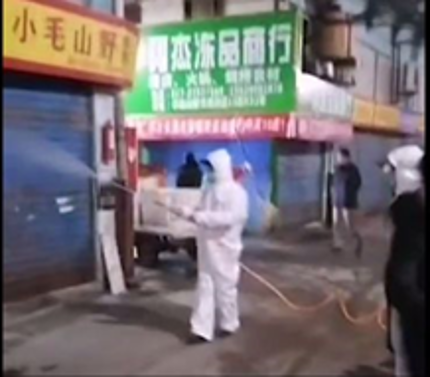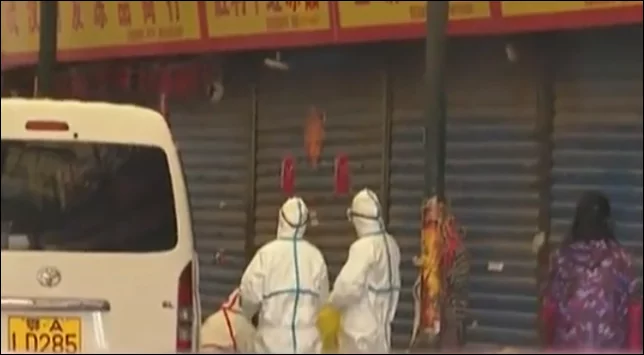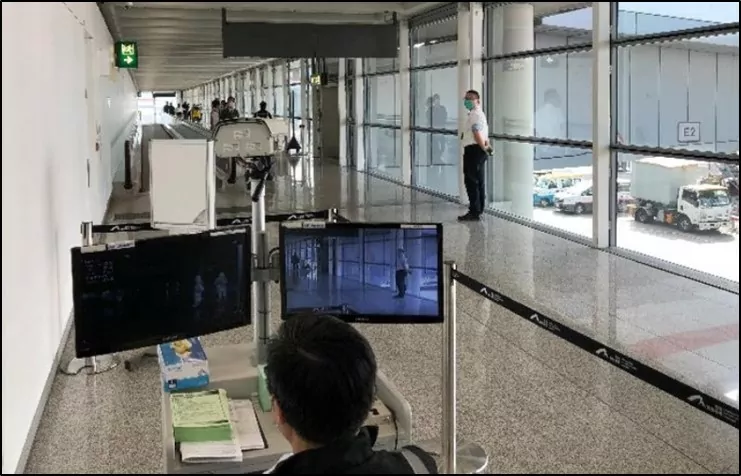
The State Response to a Mystery Viral Outbreak in Central China
Publication: China Brief Volume: 20 Issue: 1
By:

Introduction: The December Viral Outbreak in Wuhan
In December, a mysterious outbreak of infectious disease emerged in the central Chinese city of Wuhan (Hubei Province). The epicenter of the outbreak was the Wuhan Huanan Seafood Market (武汉华南海鲜批发市场, Wuhan Haixian Pifa Shichang), which was closed by officials in Wuhan on January 1 pending further investigation of the origin of the disease (see accompanying images). As of January 11, public health officials in Wuhan stated that there were a total of 41 identified cases of infection, among which two persons had been discharged from treatment, seven were seriously ill, and one person had died; 739 other persons were identified as having contact with those infected, and were to be subject to medical observation (Wuhan Health Commission, January 11).
Chinese researchers have identified the pathogen as a previously-unknown strain of coronavirus. This a large family of viruses—including the common cold, Severe Acute Respiratory Syndrome (SARS), and Middle East Respiratory Syndrome (MERS)—that are zoonotic in origin (i.e., transferred via human-animal contact) and cause respiratory illnesses with widely varying levels of severity (WHO, undated). The viral outbreak in Wuhan inspired inevitable comparisons to the SARS pandemic that originated in southern China and swept through the country (and spread to other countries) in two waves in 2002-2003 and 2003-2004. It also follows on the heels of other recent infectious zoonotic disease incidents in China, such as a minor outbreak of pneumonic and bubonic plague in Inner Mongolia in November 2019 (AFP, November 28).
The Wuhan coronavirus outbreak affords an opportunity to observe and compare the government’s handling of this latest public health crisis alongside those that have occurred in recent years. It also illustrates the continued contradictions faced by the Chinese Communist Party (CCP) in attempting to improve its capacity for governance, while also maintaining a monopoly over the public dissemination of information.

The CCP’s Impulse to Cover Up Disease Outbreaks
The People’s Republic of China (PRC) has had a troubled history in dealing with outbreaks of infectious disease, particularly when such outbreaks occur during politically “sensitive” (敏感, mingan) periods. During the initial outbreak of SARS that occurred in southern China from roughly November 2002 – April 2003, authorities actively suppressed information about the crisis. Officials under then-Guangdong Party Secretary Zhang Dejiang (张德江) imposed a media ban on news coverage of the disease until nearly mid-February; and even then the number and severity of cases was under-reported, alongside false claims that the outbreak was under control. Such decisions were taken in part due to CCP leadership anxieties about potential social unrest during the formal leadership ascension of Hu Jintao (which commenced at the November 2002 Sixteenth Party Congress, and continued through the March 2003 meeting of the National People’s Congress). This information suppression facilitated spread of the SARS virus and hampered both domestic and international efforts to combat it, contributing to the ultimate deaths of 774 people in 29 different countries or regions by the end of 2003. [1] [2]
The tendency among local and regional CCP authorities to cover up disease outbreaks is linked to a more general trend to suppress negative news. Public officials are often incentivized to cover up news stories that might embarrass political superiors, damage the local economy, or potentially stimulate social unrest. Furthermore, the vague criminal charge of “spreading rumors” (散布谣言, sanbu yaoyan) is one regularly leveled at individuals for spreading stories, whether true or false, that displease CCP officials. In a directly related example, on January 1 the Wuhan Public Security Bureau announced that 8 persons engaged in “spreading rumors” online about the virus outbreak were being “investigated and prosecuted according to law” (依法查处, yifa chachu) (Wuhan PSB, January 1). Under threat of such charges, common citizens who possess relevant information may choose to keep silent, rather than speak up and risk running afoul of the authorities.
The Government Response to the Virus in Wuhan
In many fundamental respects, PRC authorities in 2020 have been far more forthcoming with information, and far more cooperative with international public health organizations, than was the case in the SARS outbreak of 2002-2003. After closing the Wuhan Huanan Seafood Market on January 1, the Wuhan Municipal Health Commission (武汉市卫生健康委员会, Wuhan Shi Weisheng Jiankang Weiyuanhui) followed up with press releases on January 3 and 5 that offered the public several items of salient information, to include a run-down of the number of persons affected, steps to be taken to prevent further infections, and an explanation for the closure of the market (Wuhan Health Commission, January 3; Wuhan Health Commission, January 5). This provides a stark contrast with the response of Guangdong officials in the winter of 2002-2003, who blacked out public coverage of the SARS pandemic for three months while the disease rapidly spread.
Chinese officials have also shared some of the results of their initial scientific investigations with counterparts abroad: for example, Chinese medical researchers have posted the genome of the virus, under the working name “nCoV-2019” (for “novel coronavirus 2019”) in GenBank, an international genetic sequence database maintained by the U.S. Institutes of Health (CDC, January 13). PRC authorities have also cooperated with international health officials on the first reported case outside China: a traveler from Wuhan (later identified as an unnamed 61 year-old woman) who was hospitalized on January 8 in Thailand, with the case publicly reported on January 13 (WHO, January 13).
However, the current case has also indicated possible signs of the old impulse to restrict information in the face of a public crisis. The first official public acknowledgement of a problem was a December 31 notice from the Wuhan Municipal Health Commission about an unidentified “pneumonia outbreak” (肺炎疫情, feiyan yiqing) associated with the Wuhan Huanan market area, with indications that authorities had the matter under investigation (Wuhan Health Commission, December 31, 2019). In a subsequent announcement on January 5, the Wuhan Municipal Health Commission indicated that the first cases of infection were identified on December 12 (Wuhan Health Commission, January 5).
Assuming this to be correct, nearly three weeks passed between the first confirmed case of infection and the first official notice made to the public. It is unclear exactly what local health officials in Wuhan understood during this time, and it is entirely possible that local officials did not realize they faced a potential epidemic until the end of the month, after initial examinations were made of the first reported cases of illness. It is also possible, however, that news of the outbreak was deliberately kept quiet through the second half of December while local officials decided on a policy response, or while they waited for direction from national-level authorities. If the latter were to be true, this may have given the virus additional time to spread to other areas: this includes an indeterminate number of possible cases in Hong Kong linked to recent travelers from Wuhan (SCMP, January 9); and the first confirmed case in Japan, of a young man in Kanagawa Prefecture who returned home on January 6 after a trip to Wuhan (Kyodo News, January 16).

Conclusion
When compared to the secretive and reactive posture exhibited during the SARS epidemic of 17 years ago, the response of PRC officials to the virus outbreak in Wuhan has revealed a significant improvement in response time and transparency. Chinese officials have clearly gleaned valuable lessons from that earlier experience. However, there was still a significant lag time in the second half of December 2019 between the initial appearance of the virus and notification of the public. The reasons for this cannot be stated with certainty, but there was likely significant wrangling behind the scenes between local, provincial, and national-level officials regarding the proper policy response, and how much to reveal to the public. It is plausible, albeit speculative, that there was a period of policy paralysis in the last two weeks of December as officials at all levels debated the best public response to this unknown illness—one with significant implications for “social stability” in a major population center and important transportation hub.
The state response, when it did come, kicked into high gear right at the New Year: the December 31 notice by Wuhan public health officials of a disease outbreak; the January 1 market closure; the January 1 announcement of charges against persons accused of “spreading rumors” about the disease; and subsequent announcements by Wuhan public health officials through the first week of January. The timing may be coincidental, but this suggests that in late December a political decision was made to proceed with active efforts to combat spread of the virus, and to make more information available to the public—while keeping control over that flow of information tightly in government hands. On this latter point, not much has changed since 2003.
John Dotson is the editor of China Brief. For any comments, queries, or submissions, reach out to him at: cbeditor@jamestown.org.
Notes
[1] For discussion of the Chinese government’s suppression of information about SARS, see: Susan M. Puska, “SARS 2002-2003: A Case Study in Crisis Management,” in Chinese National Security Decision-Making Under Stress (Scobell and Wortzel, eds.), U.S. Army War College (Sep. 2005), pp. 85-100. https://publications.armywarcollege.edu/pubs/1726.pdf.
[2] For figures on cases of SARS-related illness and death, see: “Summary of Probable SARS Cases with Onset of Illness from 1 November 2002 to 31 July 2003” (data dated Dec. 31, 2003), World Health Organization. https://www.who.int/csr/sars/country/table2004_04_21/en/.




